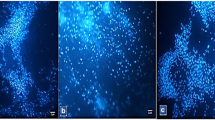We studied the possibility of seeding bone marrow-derived stromal cells onto polylactic acid-based scaffolds fabricated by electrospinning and solution blow spinning technologies. The cells were applied to the scaffolds by dynamic seeding and scaffolds were then cultured in Petri dishes in culture medium for 3 days. Cell migration to the Petri dish surface was noted only for scaffolds fabricated by electrospinning technology, but DAPI staining confirmed the presence of cells in both scaffolds. The mean number of cells in scaffolds fabricated by electrospinning and solution blow spinning was 56±9 and 81±6, respectively. The scaffold fabricated by solution blow spinning was more effectively (p<0.05) colonized by cells due to its more optimal spatial structure.
Similar content being viewed by others
References
Akhmedov ShD, Afanas’ev SA, D’yakova ML, Fatkhutdinov THh, Kakturskii LV. The use of acellular matrix for the formation of new blood vessels and the heart by the method of tissue engineering. Geny Kletki. 2009;4(2):32-39. Russian.
Zorin VL, Zorina AI, Cherkasov VR. Analysis of foreign market of regenerative medicine. Geny Kletki. 2009;4(3):68-78. Russian.
Nashchekina YA, Nikonov PO, Mikhailov VM, Pinaev GP. Distribution of bone-marrow stromal cells in a 3D scaffold depending on the seeding method and the scaffold inside a surface modification. Cell Tissue Biol. 2014;8(4):313-320.
Popov SV, Ryabov VV, Suslova TE, Shtatolkina MA, Vesnina GV, Krylov AL, Afanas’ev SA, Markov VA, Karpov RS. Fundamental and Applied Aspects of Sellular Technoloies in Cardiology and Cardiosurgery. Sib. Nauch. Med. Zh. 2008;28(4):5-15. Russian.
Shved YuA, Kukhareva LV, Zorin IM, Solovjov AYu, Blinova MI, Bilibin AYu, Pinaev GP. Elaboration of biodegradable polymer substrate for cultivation of human dermal fibroblasts. Tsitologiya. 2006;48(2):161-168. Russian.
Bol’basov EN, Lapin IN, Tverdokhlebov SI, Svetlichnyi VA. Aerodynamic synthesis of biocompatible matrices and their functionalization by nanoparticles obtained by the method of laser ablation. Russ. Phys. J. 2014;57(3):293-300.
Bolbasov EN, Stankevich KS, Sudarev EA, Bouznik VM, Kudryavtseva VL, Antonova LV, Matveeva VG, Anissimov YG, Tverdokhlebov SI. The investigation of the production method influence on the structure and properties of the ferroelectric nonwoven materials based on vinylidene fluoride-tetrafluoroethylene copolymer. Mater. Chem. Phys. 2016;182:338-346.
Daristotle JL, Behrens AM, Sandler AD, Kofinas P. A Review of the fundamental principles and applications of solution blow spinning. ACS Appl. Mater. Interfaces. 2016;8(51):34 951-34 963.
Langer R, Tirrell DA. Designing materials for biology and medicine. Nature. 2004;428:487-492.
Lou H, Han W, Wang X. Numerical study on the solution blowing annular jet and its correlation with fiber morphology. Ind. Eng. Chem. Res. 2014;53(7):2830-2838.
Melchels FPW, Domingos MAN, Klein TJ, Malda J, Bartolo PJ, Hutmacher DW. Additive manufacturing of tissues and organs. Prog. Polym. Sci. 2011. 2011;37(8):1079-1104.
Sabbatier G, Larrañaga A, Guay-Bégin AA, Fernandez J, Diéval F, Durand B, Sarasua JR, Laroche G. Design, degradation mechanism and long-term cytotoxicity of poly(L-lactide) and poly(lactide-co-ϵ-caprolactone) terpolymer film and air-spun nanofiber scaffold. Macromol. Biosci. 2015;15(10):1391-1410.
Sill TJ, von Recum HA. Electrospinning: applications in drug delivery and tissue engineering. Biomaterials. 2008;29(13): 1989-2006.
Tomecka E, Wojasinski M, Jastrzebska E, Chudy M, Ciach T, Brzozka Z. Poly(l-lactic acid) and polyurethane nanofibers fabricated by solution blow spinning as potential substrates for cardiac cell culture. Mater. Sci. Eng. C. Mater. Biol. Appl. 2017;75:305-316.
Author information
Authors and Affiliations
Corresponding author
Additional information
Translated from Kletochnye Tekhnologii v Biologii i Meditsine, No. 3, pp. 192-195, July, 2017
Rights and permissions
About this article
Cite this article
Afanasiev, S.A., Muslimova, E.F., Nashchekina, Y.A. et al. Peculiarities of Cell Seeding on Polylactic Acid-Based Scaffolds Fabricated Using Electrospinning and Solution Blow Spinning Technologies. Bull Exp Biol Med 164, 281–284 (2017). https://doi.org/10.1007/s10517-017-3973-x
Received:
Published:
Issue Date:
DOI: https://doi.org/10.1007/s10517-017-3973-x




